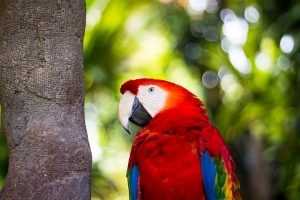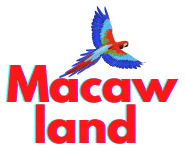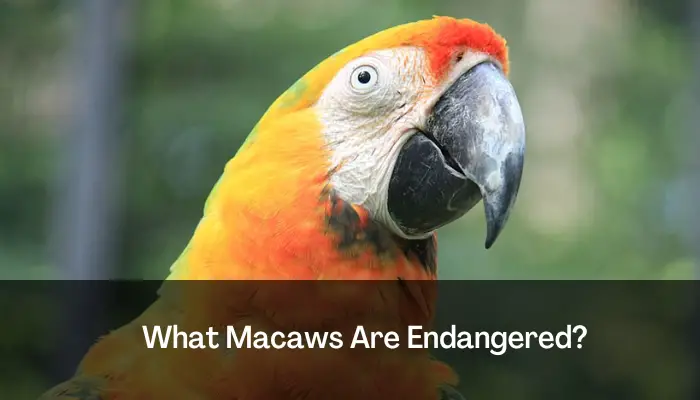There is cause for concern over the present state of all macaw species that live in the wild. At the turn of the 20th century, significant numbers were sent to both the United States and Europe as exports. The majority of macaws that live in the wild are now considered to be endangered, with several species being classified as either highly or critically endangered, others being on the verge of extinction, and at least five species have already become extinct. This is primarily the result of the rapid rate of deforestation, as well as hunting and the illegal trapping of macaws for the pet trade.
This article will provide information on endangered and extinct macaws and aim to answer all queries on may have on them.
Key Points:
- Macaws are at risk of being completely extinct. Many species of macaws are critically endangered.
- Hunting, poaching, and destruction of natural habitats are one of the main reasons why they are going extinct
- Their low birth rate makes them an extremely vulnerable species
Species Of Endangered Macaws

1) Lear’s Macaw (Endangered): Lear’s Macaw can only be found in eastern Brazil. They move, roost and feed in flocks ranging from small to medium. They are sociable parrots and can get quite big. The Lear’s Macaw faces persistent dangers from the destruction of its natural habitat, illegal killing and capturing for the pet trade, and climate change.
Poachers, who are a major contributor to the illicit bird trade, are after these stunning parrots. The scarcity of the Licur Palm, the main food source that, as was indicated before, is frequently overgrazed by animals and destroyed to make place for agricultural fields and pasture, is another source of danger for the Licur people.
2) Glaucous Macaw (Critically Endangered): Originally, the Glaucous Macaw could be found in the northern regions of Argentina, the northeastern regions of Uruguay, and southern regions of both Paraguay and Brazil, beginning in the city of Paraná and moving southward. They were most frequently spotted in the region of Corrientes, which is located in Argentina. However, they may be discovered close to major rivers.
Loss of habitat and capturing the pet bird trade are probably the two primary factors responsible for the population decrease of this species. In the past, it was common (but not necessarily widespread) in Paraguay, northern Argentina, southern Brazil, and Uruguay. The most recent possible sightings of the Glaucous Macaw were in the 90s and 2001 at Mbaracayu, which is located in Paraguay.
3) Great Green Macaw (Endangered): This species used to be rather common in North and central South America; however, due to widespread deforestation and the destruction of its natural habitat, the population of this species has significantly declined.
After extensive swaths of primary forest were cleared to make way for banana plantations, there has been a discernible decrease in the number of individuals of this species. This species relies heavily on the Mountain Almond Tree for both its nesting needs and its dietary requirements, as the Mountain Almond Tree is its primary food source.
4) Blue-Headed Macaw (Endangered): These parrots were thought to be extremely widespread in the wild until recently; however, they are currently considered endangered due to a diminishing population in the wild that is estimated to be between 1,100 and 2,600 birds and between 9,100 and 46,000 mature individuals.
These parrots are in danger of extinction due to the depletion of their natural habitat and the demand for their feathers in the rare bird market. Regrettably, these parrots are considered precious items, and collectors are willing to spend thousands of dollars for one.
5) Red-Fronted Macaw (Endangered): Only in the dry valleys of central Bolivia is it possible to find this species of parrot. Its population is quickly dwindling, partly as a result of the illegal trade in birds to supply the illegal animal trade as well as the persecution of the species by local farmers who view it as a problem.
Species of Extinct Macaws
1) Spix Macaw: The Spix’s Macaw, the smallest of the blue macaws, came to the attention of people all around the world in 2011 because of the animated film “Rio,” which was produced in Hollywood and starred the two remaining Spix’s Macaws as the main characters.
In the wild, unfortunately, the bird has been deemed to be extinct since the year 2000, making this a sad reality. The Spix’s Macaw is the rarest parrot in the world, with only about 160 individuals remaining in captivity at this time.
2) Green And Yellow Macaw: It is believed that the Green And Yellow Macaw went extinct in the late 1700s or early 1800s and hunting for food and capturing pets as the likely causes of its demise as the likely causes of their extinction.
This species of parrot is regarded to be a possible extinct parrot species because the only information about this macaw comes from Atwood’s notes; no skins, bones, or other archaeological remnants are known to be in existence.
3) Saint Croix Macaw: Remains of the extinct Saint Croix macaw have been discovered on the Caribbean islands of Saint Croix Croix and Puerto Rico.
One of the 13 extinct macaw species thought to have lived on Caribbean islands is the Saint Croix macaw. It is impossible to determine whether macaw species that are only known through bones or narratives were indigenous or imported because humans routinely moved macaws across great distances in ancient and historical times.
Why Macaws are Endangered

Macaws are endangered due to a lot of reasons. Mainly illegal animal trade, hunting, and deforestation. This has been a persistent problem for not just macaws but a lot of other animals as well.
Macaws already have a low birth rate, to begin with, and on top of that, they are hunted by poachers and sold into the black animal market. Their habitat is also destroyed frequently to make cities grow. Pollution also contributes to the demise of many of their species.
Climate change and inadequate sources of food have exhausted the bird species, leading to a severe decline in a lot of their populations.
Lastly, Macaw feathers are used as decorations and sold at high prices, which leads to excessive hunting
How to Prevent Macaws from being Extinct
The first step should be to spread the word and let others know about extinct macaws. Poaching and hunting should be heavily discouraged and regulated by the government. Heavy fines should be imposed on poachers and hunters.
Following that, the illegal black market should also be stopped. Individuals should also stop using products that are not eco and animal friendly. More natural conservation infrastructures should be built and facilitated by governments to promote the protection of the species.
Conclusion
Macaws are extremely rare birds, to begin with, and this creates a reason for hunters and poachers to target them even more as they are considered to be “collector’s items” by many.
A lot of macaw species are on the verge of extinction due to this treatment, and most of them are critically endangered too.
Unless some action is taken, the day may not be far away when the entire macaw species is wiped off the world.

Hi, I’m Regina Rios. Just another bird lover who loves to share knowledge from personal experience. I’ve grown up with pet birds since childhood as my mommy also loves birds. As I can’t pet many birds in open air in my house as my mom does; I created my first bird cage on my rooftop using wood, copper wire, and a metal shed in 2018 and start collecting pet birds. Now, I have so many pet birds such as Macaws, Parrot, Cockatiel, Parakeet, and others. Not only that, if I see natural birds are injured I keep them in my house until they get well. Now, my hobby becomes my income source as my home birds have babies and I sell them to birds lover like mine. I’ve created this blog to inspire others bird owners by sharing my personal knowledge. Good Luck!


